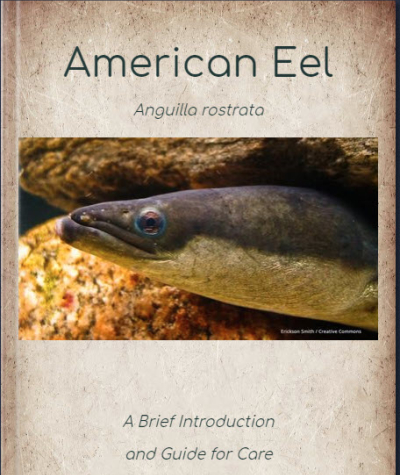Eels in the Classroom Resources
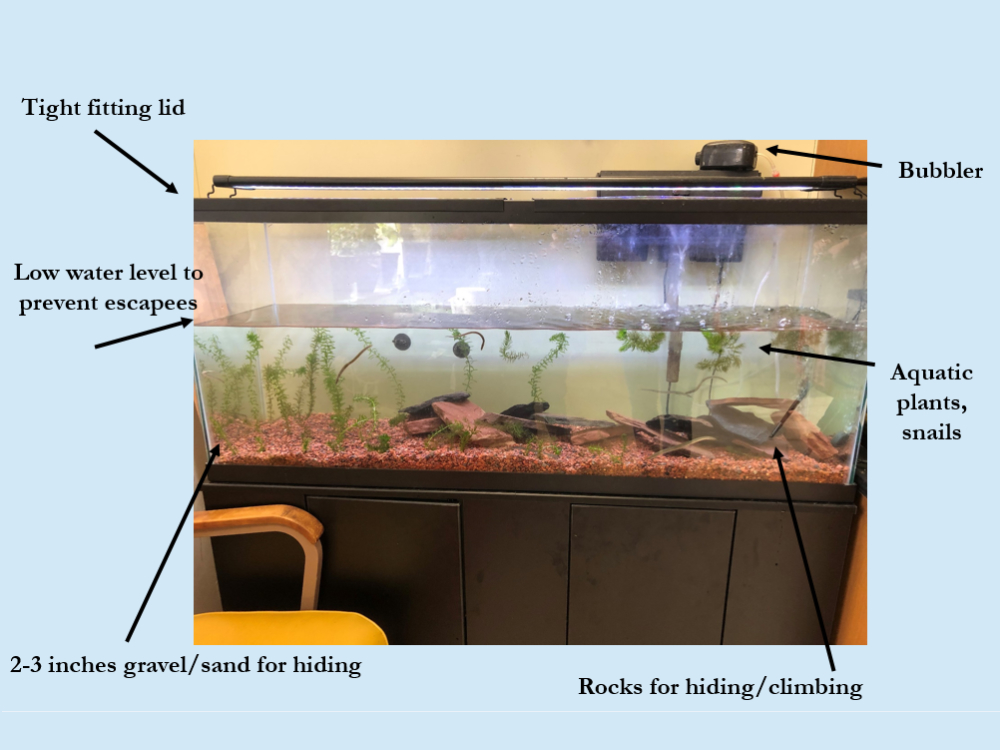 Tank photo with labels (Photo: R. Shertzer)
Tank photo with labels (Photo: R. Shertzer)
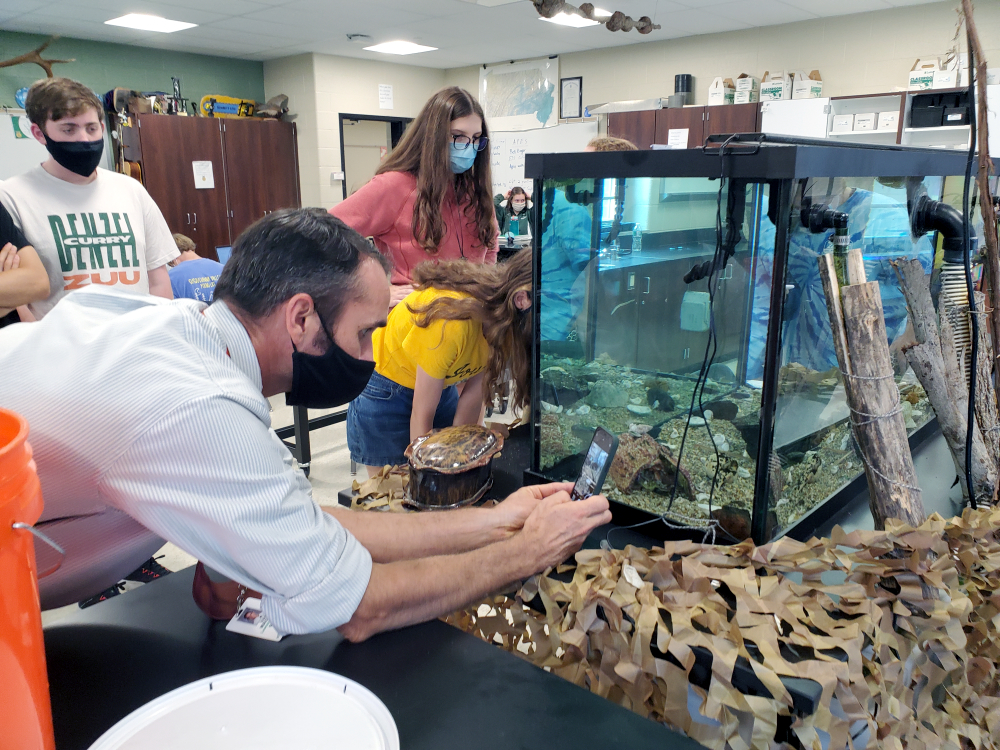 Teacher taking tank photo
Teacher taking tank photo
Classroom Eel Tank Set-up
Supplies Needed for an Eel Tank
-
Minimum 10 gallon tank, most used 30-50 gallon tanks
- Leave enough headspace and use a tight fitting lid so the eels don’t escape
- Secure top of tank with a screen or glass to prevent escaping
- Filter and filter cartridges
- Hose or siphon for water changes
- Bubbler
- Water treatment/dechloninator
- Water chemical testing kit
- In case of tank issues:
- Aquarium salt and/or tank treatment in case of illness (Ich Guard works well)
- Algaecide, as needed (API Algaefix works well)
-
Substrate
- Eels need places to hide. Think layers! Rocks from streambeds work well.
- Gravel/sand to burrow in
- Plants to rest/climb on
Helpful to Have
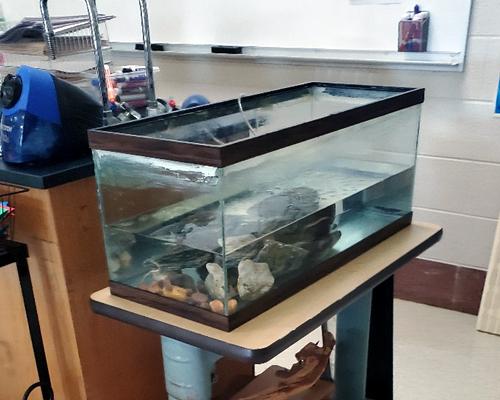 Tank
Tank
Working with your local Conservation District to apply for small grants may help fund these items:
- Full spectrum light for plants
- Automatic feeder for holidays/weekends
- Snails to help reduce algal growth
 Tank
Tank
Helpful Tips
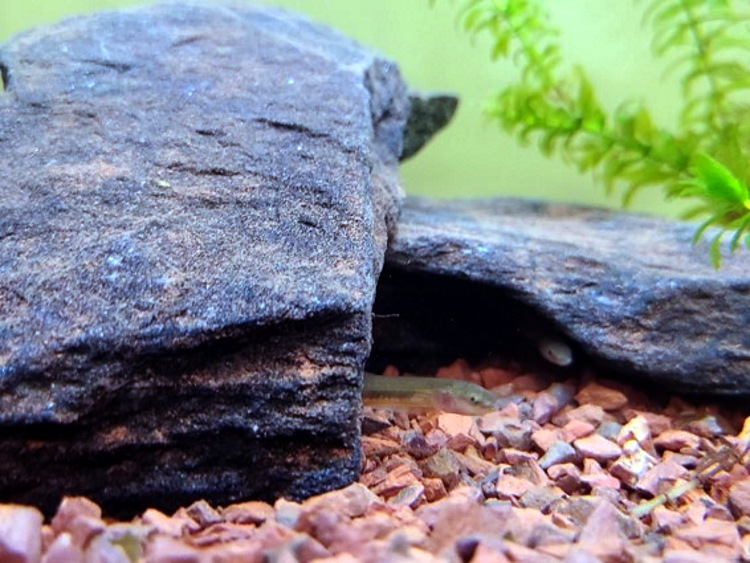 Elvers underneath rocks (Photo: Mindy Musser)
Elvers underneath rocks (Photo: Mindy Musser)
 Elver swimming (Photo: Mindy Musser)
Elver swimming (Photo: Mindy Musser)
Tank Set-up
- Setting the tank up 1 month in advance allows time for denitrifying bacteria to colonize and a biofilm to develop. This can help keep the nutrient (nitrate) load down.
- Depending on your filtration system, check if mesh needs to be added over the intake to prevent eels from swimming inside.
Disease
- Despite best efforts, being a wild animal means eels may arrive with or develop illnesses. Signs to watch out for include white spots on skin (“Ich”), lethargy, prolonged disinterest in feeding, redness and swelling around gills, excessively slimy skin, or skin flaking appearance.
- Please note American eels are a data-limited species, and your experiences help us better understand them! Please document and photograph any illnesses and share with SRBC so we can share with appropriate agencies.
- Click here for our Disease Protocol if your eels appear sick.
Behavior
- Eel behavior and activity level varies as they adjust to their new environment. Some tanks may be more active than others depending on the age of the eels.
- If your eels are quiet and only come out at night, we recommend setting up a camera to help keep students engaged.
- Eels may become more aggressive as they grow larger, this is normal!
- Some eels like to play in the bubbles or rest on the filters/tubes. Some may be very still for long periods of time but they are not dead! The eels come alive at feeding time and some may eventually eat worms out of your hand.
- If you have particularly rambunctious eels, you can use black gorilla tape to cover holes/openings around the filters and tube on the tank lid.
Feeding
- Pellets aren’t the best for food, since they often fall and become moldy when not eaten right away.
- Feeding 2-3 varieties of food is good to keep eels growing at the same rate. Try to avoid a single food source since some eels will grow quickly while others fall behind.
- Incorporating live food is beneficial, since it keeps eel from becoming “lazy” and trains them to hunt for live prey.
- Collecting stream macroinvertebrates during fall field trips offers a great food source for the eels.
- If you can, increase food size as eels grow. For example, start with blood worms and work up to earthworms once they become larger.
- Most importantly, find a feeding schedule that works for your classroom needs, and is easy to remember.
Classroom Ideas
Release Day
The release can be as small or large as you’d like!
- Eels may be difficult to remove from the tank. Plan for a few separate tries using a small net while draining water level. It’s okay to release the ones you catch and release the others later on!
- Aim to release the eels from late April-late May. The deadline to release them will be shared via email, usually the end of May.
- Look for a nearby stream you can access with your students during that time of year, and begin field trip permissions/paper work in early spring, or as needed.
- When choosing a release point, try to look for a place where the current isn’t super strong, and try to find a place that appears to have a good amount of natural underwater structures such as rocks, down trees, vegetation, etc. on the bottom. This provides the young elvers safety and food in their new environment.
- Waiting until the latest possible date in the school year to release them is best if possible, as water temperature will be closer to their previous tank environment, minimizing shock associated with acclimating to life in the wild.
Eel release video
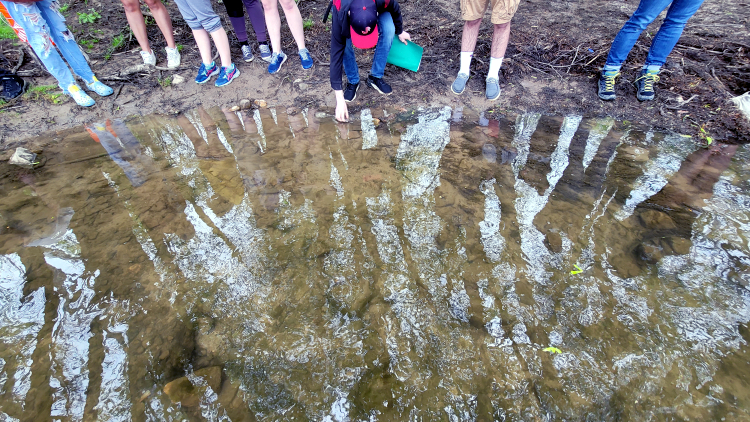 Eel release, Juniata
Eel release, Juniata
 Eel release, Juniata
Eel release, Juniata
Eel Release Day Ideas
- SRBC is happy to join for eel releases if schedules allow. We may be able to provide an electrofishing demo that day (stream flow and weather dependent) and talk about careers in environmental science.
- Some schools create full day events, such as partnering with local Conservation District to create an Envirothon Day with students rotating through water quality related stations.
- Instead of a final project or test, the release day could provide an opportunity for students to demo what they learned about the eels throughout the school year.
- Because the eels are still small and swim away quickly, the release itself can happen quickly and be difficult to see. Try using underwater cameras to capture the release, and make sure to keep students engaged leading up to the release.
- Have plans for after, such as a game or classroom discussion demonstrating what the eels will encounter on their next journey.
-
Cross-curriculum ideas:
- Geography: Mapping their journey back to the Saragasso Sea? How many miles is it?
- English classes: Graduation speech or a poem for the release date?
Eels video
More Resources
Current EIC Teachers: There is a shared Google Drive with access to NGSS aligned curriculum and activities for preK-12th grades based on American eel ecology, life cycle, migration, and current management issues. Please contact [email protected] if you need access.
